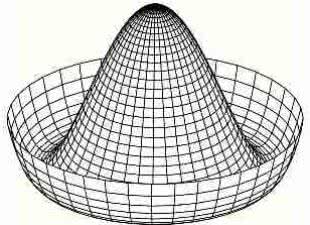Part 2 is here :
http://www.cramster.com/answers-nov-10/physics/rotating-pendulum-part-2-rotating-pendulum-part-ii-note-part-httpww_1015121.aspx
This is the same rotating pendulum of the previous two problems.Now it is time to analyze the diï¬erent types of motion andequilibrium (according to the initial conditions).
Note: The âeï¬ective potentialâ method is a powerful tool to analyzeand solve problems where the Hamiltonian is conserved. A similartechnique is used for central potentials, including the Keplerproblem of celestial mechanics (two-body gravitationalproblem)âwill see that later.
(a) Let us call Eeï¬ â¡ H the âeï¬ective energy.â To make it look likea real energy, deï¬ne Eeï¬ = T2 + Veï¬ , where Veï¬ should include therelevant non-quadratic piece of kinetic energy (which eï¬ectivelybehaves, with an appropriate sign, as a potential energycontribution). In short, the eï¬ective potential is deï¬ned so thatthe eï¬ective kinetic energy left in the Hamiltonian is justquadratic.
Your task: Find the corresponding eï¬ective potential Veï¬ (θ), i.e.,write it down explicitly as a function of θ.
Hint: Using the resolution T = T0 + T1 + T2 , it should follow thatVeï¬ = V â T0 (using
Eulerâs theorem for homogeneous functions).
(b) Analyze all possible shapes of the graph of the eï¬ectivepotential Veï¬ (θ) (versus θ). For this purpose, simply use calculusand the techniques for energy graphs that we studied withone-dimensional systems. Speciï¬cally, you should plot Veï¬ (θ) andï¬nd the extrema.
Hint: There should be two diï¬erent regimes (or two âfamiliesâ ofshapes).
(c) At what rotation rate Ïc does the stationary point at θ = 0become unstable?
(d) For Ï > Ïc , what is the stable equilibrium value ofθ?
Explain the physical meaning of this stable âdynamic equilibriumâvalue. Also explain in simple terms why θ = 0 is a stable âdynamicequilibriumâ position for Ï < Ïc .
(e) What is the frequency Ω of small oscillations about theâdynamic equilibriumâ points (for each of the two regimesdiscovered above)? Compute this frequency in two diï¬erentways:
(i) using the eï¬ective potential; and (ii) linearizing the equationof motion.

Part 2 is here :
http://www.cramster.com/answers-nov-10/physics/rotating-pendulum-part-2-rotating-pendulum-part-ii-note-part-httpww_1015121.aspx
This is the same rotating pendulum of the previous two problems.Now it is time to analyze the diï¬erent types of motion andequilibrium (according to the initial conditions).
Note: The âeï¬ective potentialâ method is a powerful tool to analyzeand solve problems where the Hamiltonian is conserved. A similartechnique is used for central potentials, including the Keplerproblem of celestial mechanics (two-body gravitationalproblem)âwill see that later.
(a) Let us call Eeï¬ â¡ H the âeï¬ective energy.â To make it look likea real energy, deï¬ne Eeï¬ = T2 + Veï¬ , where Veï¬ should include therelevant non-quadratic piece of kinetic energy (which eï¬ectivelybehaves, with an appropriate sign, as a potential energycontribution). In short, the eï¬ective potential is deï¬ned so thatthe eï¬ective kinetic energy left in the Hamiltonian is justquadratic.
Your task: Find the corresponding eï¬ective potential Veï¬ (θ), i.e.,write it down explicitly as a function of θ.
Hint: Using the resolution T = T0 + T1 + T2 , it should follow thatVeï¬ = V â T0 (using
Eulerâs theorem for homogeneous functions).
(b) Analyze all possible shapes of the graph of the eï¬ectivepotential Veï¬ (θ) (versus θ). For this purpose, simply use calculusand the techniques for energy graphs that we studied withone-dimensional systems. Speciï¬cally, you should plot Veï¬ (θ) andï¬nd the extrema.
Hint: There should be two diï¬erent regimes (or two âfamiliesâ ofshapes).
(c) At what rotation rate Ïc does the stationary point at θ = 0become unstable?
(d) For Ï > Ïc , what is the stable equilibrium value ofθ?
Explain the physical meaning of this stable âdynamic equilibriumâvalue. Also explain in simple terms why θ = 0 is a stable âdynamicequilibriumâ position for Ï < Ïc .
(e) What is the frequency Ω of small oscillations about theâdynamic equilibriumâ points (for each of the two regimesdiscovered above)? Compute this frequency in two diï¬erentways:
(i) using the eï¬ective potential; and (ii) linearizing the equationof motion.
